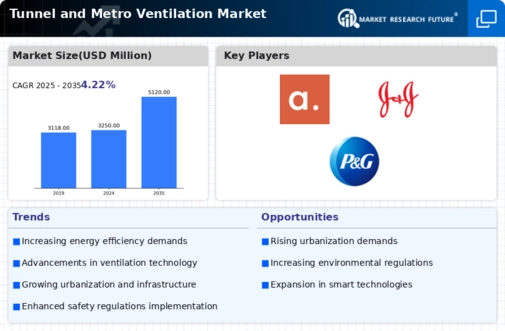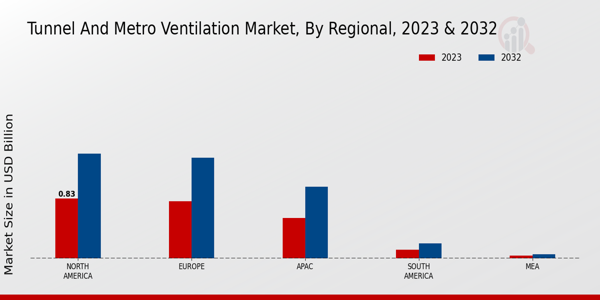Increasing Urbanization
The rapid pace of urbanization is a primary driver for the Tunnel and Metro Ventilation Market. As cities expand, the demand for efficient public transportation systems rises, necessitating the construction of new metro lines and tunnels. This trend is evident in various regions, where urban populations are projected to increase significantly over the next decade. Consequently, the need for effective ventilation systems in these infrastructures becomes paramount to ensure air quality and safety. The market for tunnel and metro ventilation is expected to grow as municipalities invest in modernizing their transit systems to accommodate larger populations. This growth is likely to be accompanied by advancements in ventilation technologies, which aim to enhance energy efficiency and reduce operational costs, further propelling the market forward.
Technological Advancements
Technological innovations play a crucial role in shaping the Tunnel and Metro Ventilation Market. The integration of advanced ventilation systems, such as automated controls and energy-efficient fans, is becoming increasingly prevalent. These technologies not only improve air quality but also optimize energy consumption, which is a growing concern among transit authorities. The market is witnessing a shift towards smart ventilation solutions that utilize real-time data to adjust airflow based on passenger density and environmental conditions. This trend is supported by the increasing investment in research and development, which aims to enhance the performance and reliability of ventilation systems. As a result, the market is expected to experience substantial growth, driven by the demand for smarter, more efficient ventilation solutions in metro and tunnel applications.
Rising Environmental Concerns
Rising environmental concerns are increasingly influencing the Tunnel and Metro Ventilation Market. As awareness of air quality and climate change grows, there is a heightened emphasis on sustainable practices within the transportation sector. This shift is prompting transit authorities to seek ventilation solutions that minimize energy consumption and reduce greenhouse gas emissions. The market is responding to this demand by developing eco-friendly ventilation systems that utilize renewable energy sources and advanced filtration technologies. Furthermore, regulatory bodies are implementing stricter environmental regulations, which compel metro systems to adopt greener practices. Consequently, the market is expected to expand as stakeholders prioritize sustainability in their ventilation strategies, aligning with broader environmental goals.
Safety Regulations and Standards
Safety regulations and standards are a critical driver of the Tunnel and Metro Ventilation Market. As urban transit systems become more complex, the need for stringent safety measures has intensified. Regulatory bodies are establishing comprehensive guidelines that dictate the design and operation of ventilation systems in tunnels and metro stations. These regulations aim to ensure the safety of passengers and staff, particularly in emergency situations where smoke control and air quality are paramount. Compliance with these standards often necessitates the adoption of advanced ventilation technologies, which can effectively manage air flow and maintain safe conditions. As authorities enforce these regulations, the market is likely to witness increased demand for compliant ventilation solutions, thereby fostering growth in the industry.
Government Initiatives and Funding
Government initiatives and funding are pivotal in driving the Tunnel and Metro Ventilation Market. Many governments are prioritizing investments in public transportation infrastructure to alleviate traffic congestion and reduce carbon emissions. This focus often translates into substantial financial support for the development of metro systems and associated ventilation technologies. For instance, various countries have announced multi-billion dollar budgets aimed at enhancing urban transit networks, which includes the installation of state-of-the-art ventilation systems. Such funding not only facilitates the construction of new tunnels and metro lines but also encourages the adoption of innovative ventilation solutions that comply with modern safety and environmental standards. As these initiatives continue to unfold, the market is likely to see a surge in demand for advanced ventilation systems.















Leave a Comment